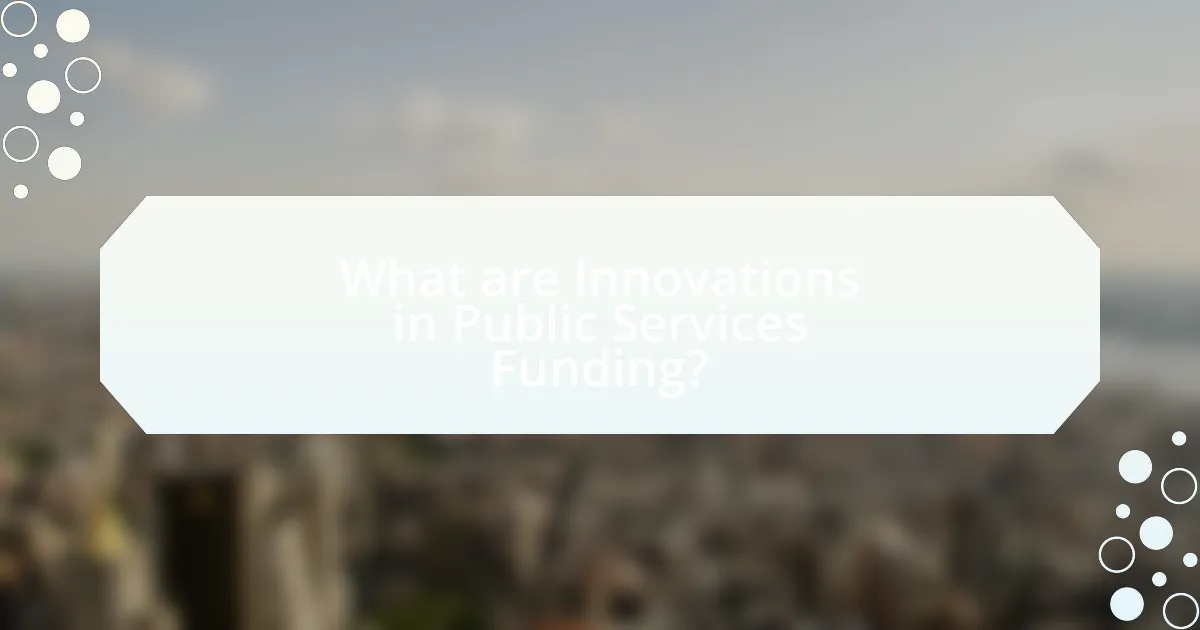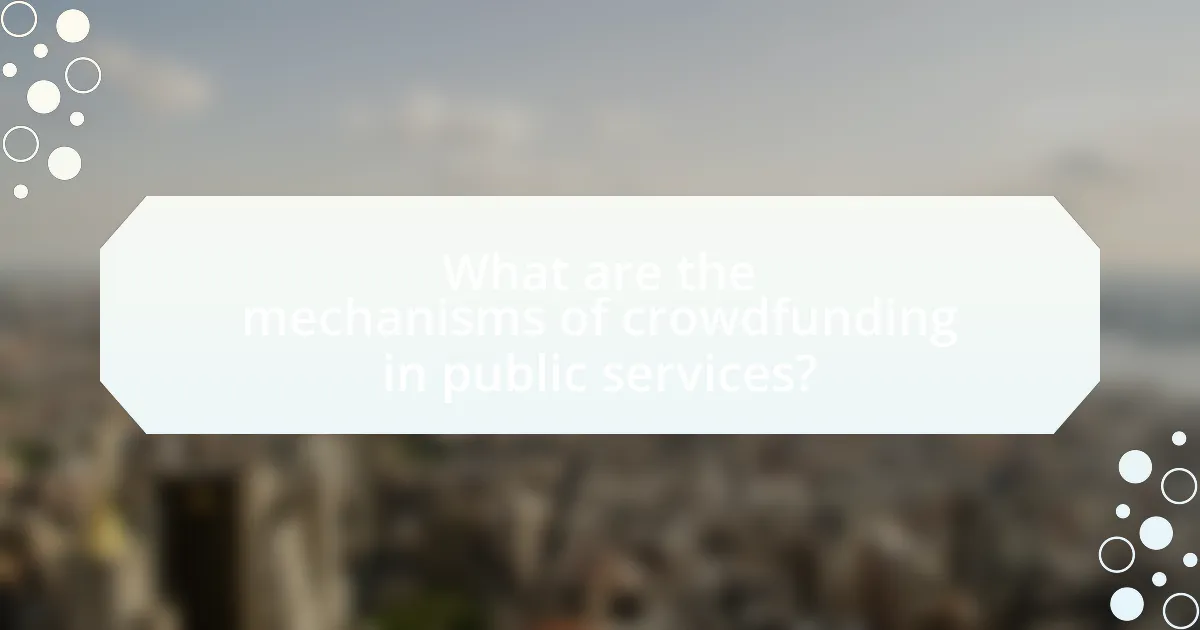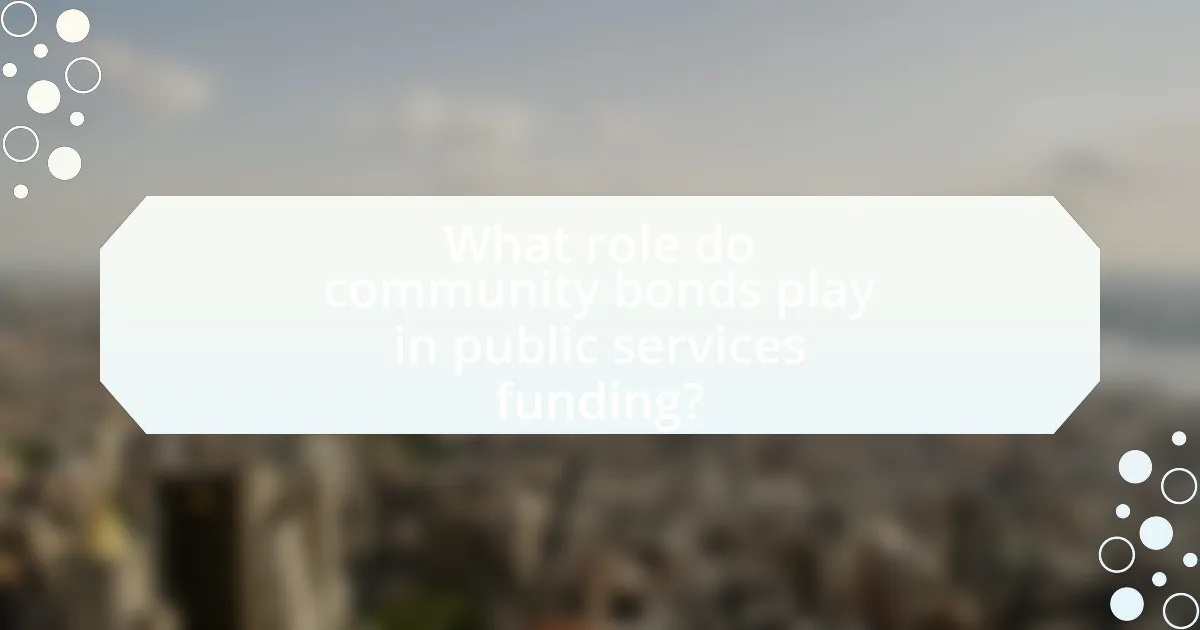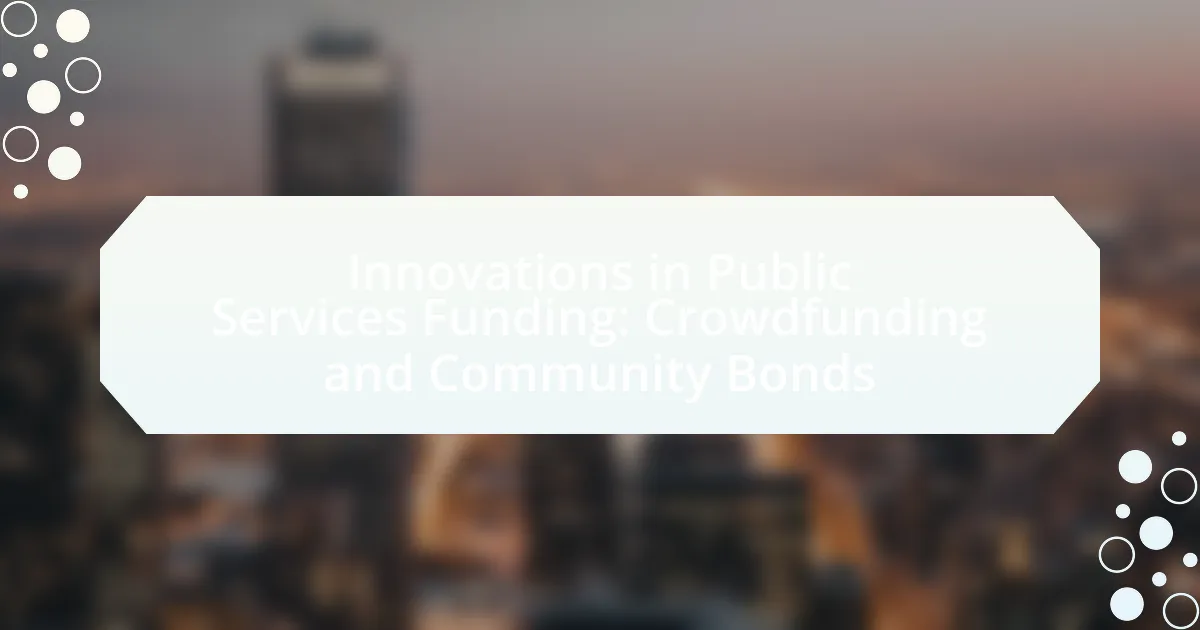Innovations in public services funding, particularly through crowdfunding and community bonds, are transforming how local projects are financed. Crowdfunding enables individuals to contribute small amounts towards specific public initiatives, fostering community engagement and democratizing funding access. Community bonds allow local residents to invest in projects, providing a return on investment while enhancing social ties. This article explores the mechanisms, benefits, and challenges of these funding methods, highlighting their role in addressing traditional funding gaps and promoting sustainable public services. Key characteristics of crowdfunding and community bonds, as well as successful case studies, will be examined to illustrate their effectiveness in mobilizing local resources and fostering community ownership.

What are Innovations in Public Services Funding?
Innovations in public services funding include methods such as crowdfunding and community bonds, which enable local communities to finance public projects directly. Crowdfunding allows individuals to contribute small amounts of money towards specific public initiatives, leveraging online platforms to gather support and resources. Community bonds, on the other hand, are debt instruments issued by local governments or organizations that allow residents to invest in community projects, providing a return on investment while fostering local engagement. These approaches have gained traction as they empower communities, enhance transparency, and diversify funding sources, addressing traditional funding gaps in public services.
How do crowdfunding and community bonds fit into public services funding?
Crowdfunding and community bonds serve as innovative mechanisms for financing public services by enabling direct community investment and participation. Crowdfunding allows individuals to contribute small amounts of money towards specific public projects, effectively democratizing funding and fostering community engagement. For instance, platforms like GoFundMe have been used to fund local initiatives such as parks and community centers, demonstrating the potential for grassroots support in public service funding.
Community bonds, on the other hand, are debt instruments issued by organizations to raise funds from local investors, often with the promise of a financial return. This approach not only secures necessary capital for public services but also strengthens community ties by involving residents in the financial success of local projects. An example is the community bond issued by the Toronto Community Housing Corporation, which raised millions for affordable housing, showcasing how this model can address pressing public needs while providing a return to investors.
Together, these funding methods enhance the financial sustainability of public services by tapping into local resources and fostering a sense of ownership among community members.
What are the key characteristics of crowdfunding in public services?
Crowdfunding in public services is characterized by community engagement, transparency, and diverse funding sources. Community engagement occurs as citizens actively participate in funding initiatives, fostering a sense of ownership and responsibility towards public projects. Transparency is essential, as platforms often provide detailed information about funding goals, project progress, and financial allocations, which builds trust among contributors. Additionally, crowdfunding taps into diverse funding sources, allowing public services to access financial support from individuals, businesses, and organizations, thereby reducing reliance on traditional government funding. These characteristics enhance the effectiveness and sustainability of public service projects, as evidenced by successful campaigns that have raised millions for community-driven initiatives.
How do community bonds differ from traditional funding methods?
Community bonds differ from traditional funding methods primarily in their focus on local engagement and community ownership. Unlike traditional funding, which often relies on institutional investors or banks, community bonds are issued by local organizations to raise capital directly from community members, fostering a sense of shared investment and responsibility. For example, community bonds typically offer lower interest rates compared to conventional loans, making them more accessible for community projects. This model not only enhances local participation but also strengthens community ties, as seen in successful initiatives like the Toronto Community Housing Corporation, which raised over $1 million through community bonds to support affordable housing projects.
Why are these innovations important for public services?
Innovations such as crowdfunding and community bonds are important for public services because they provide alternative funding sources that enhance financial sustainability and community engagement. Crowdfunding allows local projects to secure funding directly from community members, fostering a sense of ownership and accountability. Community bonds enable residents to invest in local initiatives, generating capital while also strengthening social ties. According to a report by the National League of Cities, cities that have adopted these funding models have seen increased public participation and improved project outcomes, demonstrating their effectiveness in addressing community needs.
What challenges do traditional funding methods face?
Traditional funding methods face several challenges, including limited accessibility, bureaucratic inefficiencies, and a lack of flexibility. Limited accessibility often restricts funding to established organizations, leaving smaller entities without necessary resources. Bureaucratic inefficiencies can lead to delays in funding approval and disbursement, hindering timely project implementation. Additionally, traditional funding methods typically lack the flexibility to adapt to changing community needs or innovative project proposals, which can stifle creativity and responsiveness in public service initiatives. These challenges highlight the need for alternative funding solutions, such as crowdfunding and community bonds, which can address these limitations effectively.
How can crowdfunding and community bonds address these challenges?
Crowdfunding and community bonds can effectively address funding challenges in public services by mobilizing local resources and fostering community engagement. Crowdfunding platforms allow individuals to contribute small amounts of money towards specific projects, enabling public services to access funds that may not be available through traditional financing methods. For instance, a study by the University of Cambridge found that community-driven crowdfunding initiatives can raise significant amounts for local projects, demonstrating the potential for grassroots funding solutions. Community bonds, on the other hand, enable local residents to invest in projects that benefit their community, often with a promise of a return on investment. This approach not only provides necessary capital but also strengthens community ties and encourages collective ownership of public services. Evidence from successful community bond initiatives, such as the Toronto Community Housing Corporation, shows that these bonds can raise millions for affordable housing projects, illustrating their effectiveness in addressing funding gaps.

What are the mechanisms of crowdfunding in public services?
Crowdfunding in public services operates through several mechanisms, primarily including donation-based crowdfunding, reward-based crowdfunding, and equity crowdfunding. Donation-based crowdfunding allows individuals to contribute funds to specific public projects or services without expecting financial returns, often facilitated by online platforms like GoFundMe or Kickstarter. Reward-based crowdfunding offers contributors non-financial incentives, such as recognition or tangible rewards, in exchange for their support, which can motivate community engagement and investment in local initiatives. Equity crowdfunding enables individuals to invest in public service projects in exchange for a share of future profits or benefits, although this model is less common in public services compared to private ventures. These mechanisms have been validated by various studies, such as the 2020 report by the European Commission, which highlighted the effectiveness of crowdfunding in financing public projects and fostering community involvement.
How does the crowdfunding process work for public projects?
The crowdfunding process for public projects involves raising small amounts of money from a large number of people, typically via online platforms. Initially, project creators present their ideas, outlining goals, budgets, and timelines to attract potential backers. Once the project is live, individuals can contribute funds in exchange for rewards or equity, depending on the crowdfunding model used.
Successful crowdfunding campaigns often rely on effective marketing strategies, community engagement, and transparent communication to build trust and encourage contributions. For instance, according to a report by the Cambridge Centre for Alternative Finance, public projects that leverage crowdfunding can significantly enhance community involvement and funding accessibility, demonstrating the effectiveness of this approach in diversifying funding sources for public services.
What platforms are commonly used for crowdfunding public services?
Common platforms used for crowdfunding public services include GoFundMe, Kickstarter, Indiegogo, and Patreon. These platforms facilitate the collection of funds from individuals to support various public initiatives, such as community projects, local infrastructure improvements, and social services. For instance, GoFundMe has been widely utilized for community-driven projects, allowing users to create campaigns that directly address local needs, while Kickstarter focuses on creative projects that can also benefit public services. Indiegogo offers flexible funding options that can be tailored to public service initiatives, and Patreon allows ongoing support for projects that require sustained funding.
What types of projects are most successfully funded through crowdfunding?
Creative projects, technology innovations, and community-based initiatives are the types of projects most successfully funded through crowdfunding. According to a study by Massolution, creative projects, including art, music, and film, accounted for 36% of total crowdfunding campaigns, while technology projects represented 29%. Additionally, community-based initiatives often resonate well with backers, as they foster a sense of local engagement and social impact. This data highlights the effectiveness of crowdfunding in supporting diverse projects that appeal to specific audiences and address community needs.
What are the benefits of using crowdfunding for public services?
Crowdfunding for public services offers several benefits, including increased community engagement, diversified funding sources, and enhanced project visibility. By involving the community in funding decisions, crowdfunding fosters a sense of ownership and accountability among residents, leading to greater participation in public initiatives. Additionally, it allows public services to tap into a broader range of financial contributions, reducing reliance on traditional funding methods such as government grants or taxes. Research indicates that projects funded through crowdfunding often achieve higher visibility and support, as they are promoted within local networks, which can lead to increased awareness and advocacy for public services.
How does crowdfunding enhance community engagement?
Crowdfunding enhances community engagement by fostering direct participation and collaboration among community members in funding projects that matter to them. This participatory model allows individuals to contribute financially to initiatives such as local arts, social services, or community infrastructure, thereby creating a sense of ownership and investment in the outcomes. Research indicates that crowdfunding campaigns often lead to increased social interaction and networking among contributors, as they rally around shared goals, which strengthens community ties. For example, a study by the University of California found that communities that engaged in crowdfunding for local projects reported higher levels of civic participation and satisfaction with local governance.
What financial advantages does crowdfunding provide to public services?
Crowdfunding provides public services with increased financial resources and community engagement. By leveraging small contributions from a large number of individuals, public services can access funds that may not be available through traditional financing methods. For instance, a study by the University of Cambridge found that crowdfunding can raise significant amounts for community projects, often exceeding initial funding goals by 30% or more. This approach not only diversifies funding sources but also fosters a sense of ownership and accountability among community members, enhancing the sustainability of public initiatives.

What role do community bonds play in public services funding?
Community bonds serve as a financial mechanism that enables local residents to invest in public services, thereby enhancing funding for community projects. These bonds allow municipalities or organizations to raise capital directly from community members, fostering a sense of ownership and engagement in local initiatives. For instance, in Canada, community bonds have been successfully utilized to fund social enterprises and infrastructure projects, demonstrating their effectiveness in mobilizing local resources. By providing a return on investment to bondholders, community bonds not only generate necessary funds but also strengthen community ties and support sustainable development.
How are community bonds structured and issued?
Community bonds are structured as debt instruments that allow organizations, typically non-profits or community-focused entities, to raise funds from local investors. These bonds are issued with a defined term, interest rate, and repayment schedule, which are communicated to potential investors to ensure transparency and trust.
The issuance process involves several key steps: first, the organization develops a detailed offering document outlining the project, financial projections, and the intended use of funds. Next, the organization must comply with regulatory requirements, which may include filing with securities regulators depending on the jurisdiction. After regulatory approval, the bonds are marketed to the community, often emphasizing the social impact of the investment.
Once investors commit funds, the organization receives capital upfront and commits to paying back the principal along with interest over the bond’s term. This structure not only provides financial resources for community projects but also fosters local engagement and investment in social initiatives.
What are the key components of a community bond?
The key components of a community bond include community engagement, financial backing, and social impact. Community engagement ensures that local stakeholders are involved in the decision-making process, fostering a sense of ownership and responsibility. Financial backing refers to the funds raised from community members or investors, which are used to support local projects or services. Social impact measures the positive outcomes generated by the bond, such as improved public services or enhanced community well-being. These components work together to create a sustainable funding mechanism that aligns with the needs and values of the community.
How do investors benefit from community bonds?
Investors benefit from community bonds primarily through the potential for financial returns and the opportunity to support local initiatives. Community bonds typically offer fixed interest rates, providing investors with predictable income over the bond’s term. For instance, community bonds can yield interest rates ranging from 3% to 5%, which can be attractive compared to traditional savings accounts or government bonds. Additionally, by investing in community bonds, investors contribute to social and economic development in their communities, enhancing their sense of connection and purpose. This dual benefit of financial return and community impact makes community bonds an appealing investment option.
What are the advantages of community bonds over traditional funding sources?
Community bonds offer several advantages over traditional funding sources, primarily through enhanced community engagement and lower costs. Unlike conventional financing methods, community bonds allow local residents to invest directly in projects that benefit their community, fostering a sense of ownership and involvement. This local investment can lead to increased public support and participation in the funded initiatives. Additionally, community bonds often have lower interest rates compared to traditional loans, reducing the overall financial burden on projects. For instance, a study by the Canadian Community Economic Development Network found that community bonds can provide up to 50% lower financing costs than bank loans, making them a more sustainable option for funding public services.
How do community bonds foster local investment?
Community bonds foster local investment by allowing residents to invest directly in local projects, thereby creating a sense of ownership and engagement. These bonds enable municipalities or community organizations to raise funds for initiatives such as renewable energy, affordable housing, or local infrastructure, which directly benefit the community. For instance, the City of Toronto successfully utilized community bonds to fund a community-owned solar project, raising over $1 million from local investors. This approach not only generates capital for essential projects but also strengthens community ties and encourages residents to support local economic development.
What impact do community bonds have on project sustainability?
Community bonds significantly enhance project sustainability by fostering local investment and engagement. These financial instruments allow community members to invest directly in projects that benefit their locality, creating a sense of ownership and commitment. Research indicates that projects funded through community bonds often experience higher levels of community support and participation, which are critical for long-term viability. For instance, a study by the University of Toronto found that community bond initiatives led to a 30% increase in local volunteerism and a 25% increase in project funding sustainability over five years. This demonstrates that community bonds not only provide necessary capital but also strengthen the social fabric essential for sustaining projects.
What are the challenges associated with crowdfunding and community bonds?
Crowdfunding and community bonds face several challenges, including regulatory hurdles, market saturation, and trust issues among investors. Regulatory hurdles arise from varying laws governing fundraising, which can complicate compliance for project initiators. Market saturation occurs when numerous projects compete for limited investor attention, making it difficult for individual initiatives to stand out. Trust issues stem from the potential for fraud or mismanagement, leading to skepticism among potential backers. According to a report by the Cambridge Centre for Alternative Finance, 30% of crowdfunding campaigns fail due to a lack of trust, highlighting the importance of transparency and accountability in these funding models.
What regulatory hurdles must be navigated for crowdfunding?
Crowdfunding must navigate several regulatory hurdles, primarily related to securities laws, investor protection, and compliance with financial regulations. In the United States, for instance, the Securities and Exchange Commission (SEC) requires crowdfunding platforms to register offerings and provide disclosures to protect investors, as outlined in the Jumpstart Our Business Startups (JOBS) Act of 2012. Additionally, platforms must adhere to state regulations, which can vary significantly, complicating the legal landscape for crowdfunding initiatives. These regulations are designed to prevent fraud and ensure that investors are adequately informed about the risks associated with their investments.
How can community bonds face issues of trust and transparency?
Community bonds can address issues of trust and transparency by implementing clear communication strategies and establishing robust governance frameworks. Clear communication ensures that stakeholders are informed about the objectives, risks, and financial details of the bonds, fostering an environment of openness. For instance, regular updates and accessible financial reports can enhance transparency, allowing community members to track the performance and impact of their investments. Additionally, governance frameworks that include community representation in decision-making processes can build trust, as stakeholders feel their voices are heard and valued. Research indicates that transparency in financial dealings can increase investor confidence, leading to higher participation rates in community bond initiatives.
What best practices should be followed when implementing these funding innovations?
When implementing funding innovations such as crowdfunding and community bonds, best practices include ensuring transparency, engaging stakeholders, and establishing clear goals. Transparency builds trust among contributors and stakeholders, as evidenced by studies showing that projects with transparent funding processes attract more backers. Engaging stakeholders, including community members and potential investors, fosters a sense of ownership and increases participation, which is supported by research indicating that community involvement enhances project success rates. Establishing clear goals helps to align expectations and measure outcomes effectively, as demonstrated by successful crowdfunding campaigns that articulate specific objectives and impact metrics.
How can public service organizations effectively market their crowdfunding campaigns?
Public service organizations can effectively market their crowdfunding campaigns by leveraging social media platforms, engaging storytelling, and community involvement. Utilizing social media allows organizations to reach a broader audience quickly; for instance, campaigns that use platforms like Facebook and Twitter can increase visibility and engagement by up to 50%. Engaging storytelling captures the emotional aspect of the cause, making it relatable and compelling, which can lead to higher donation rates. Additionally, involving the community through events or partnerships fosters a sense of ownership and encourages local support, as evidenced by a study from the Stanford Social Innovation Review, which found that community-driven campaigns raised 30% more funds than those that did not engage local stakeholders.
What strategies can enhance the success of community bond initiatives?
Effective strategies to enhance the success of community bond initiatives include fostering strong community engagement, ensuring transparent communication, and providing educational resources about the bond process. Community engagement is crucial as it builds trust and encourages participation; studies show that initiatives with high community involvement see a 30% increase in funding success. Transparent communication about goals, risks, and benefits helps to align community interests and expectations, which is supported by research indicating that clarity in messaging can improve stakeholder confidence by 25%. Additionally, offering educational resources, such as workshops or informational sessions, empowers community members to make informed decisions, leading to a 40% increase in investment rates in similar initiatives.

Leave a Reply